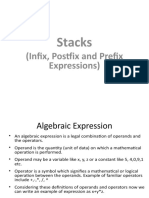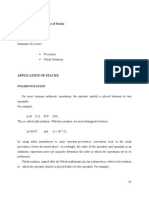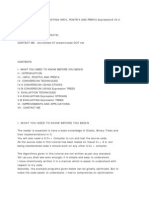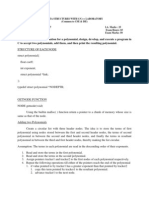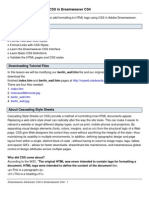CSS 502 Programming Assignment #1
Uploaded by
Marcus Skookumchuck VanniniCSS 502 Programming Assignment #1
Uploaded by
Marcus Skookumchuck VanniniCSS 502 Programming assignment #1 (Due: Tuesday, April 27, 2010) Spring 2010
PART 1 (programming):
Write a program to evaluate a prefix expression and to convert a prefix expression to postfix using recursion. You may
assume each expression is a valid prefix expression where the operands consist of just one digit and the operators are
either + ,- , *, / . For simplicity, use integer arithmetic (answer is an int). E.g., (3+4)/2 which is /+342 in prefix
notation, results in the answer of 3 and is 34+2/ in postfix notation.
By definition, an infix expression is leftOperand operator rightOperand
e.g., a+b (leftOp operator rightOp). In a prefix expression, the operator is first. In postfix, the operator is last.
E.g., a+b becomes +ab (operator leftOp rightOp) in prefix notation, and ab+ (leftOp rightOp operator) in postfix.
In prefix or postfix expressions, there is no need for parentheses to change the order of operations. The precedence
of the operators is built into the expression. Humans prefer infix expressions, but computer programs prefer prefix
or postfix expressions (so the expression can be easily scanned to figure out which operation to do first).
In the data, there is one prefix expression per line. You can assume valid prefix expressions with single digit operand.
For example, with the sample input the sample output looks as
+23 Prefix Expression = Answer
-+231 --------------------------
*+51-24 +23 = 5 As postfix: 23+
/*+91-42+53 -+231 = 4 As postfix: 23+1-
*+51-24 = -12 As postfix: 51+24-*
/*+91-42+53 = 2 As postfix: 91+42-*53+/
Notes
-- To evaluate a prefix expression, the key to the recursion is that every prefix expression is made up of an operator
followed by 2 operands and each of the operands is itself a prefix expression. The simplest of prefix expressions is a
single digit (number). The function isdigit() is useful for determining if a char is a digit or not. The recursive solution
to convert a prefix expression to postfix is similar to evaluating a prefix expression.
-- While it is still object-oriented, the assignment focus is on recursion. The prefix expression is stored in an array.
The function to evaluate itself is very short. If you are doing a lot of work, then you are doing it incorrectly. At the
beginning of the recursive routine, the next symbol in the expression is considered.
-- The type char can also be treated as an int. If you assign a char to an int, it will yield the ascii value. For example,
int i = 'a'; gives i the ascii value of 97. So, you can turn a char '2' into an int 2 using the code i = ch - '0';
The difference in ascii values (which you don't even need to know) of character '2' and character '0' is integer 2.
-- So that you don't get hung up on the reading, all the reading and printing for the assignment is given. You can find
main and a partial Prefix class linked off the assignments page. You wont do any other reading than what is given. So
that the given main works properly, be sure in your data files on a PC, the cursor is on the line following the last
expression. When you're solving this problem, all that is left is the recursion so you can focus on the recursive
problem solving. Think high-level to solve this program. Focus on prefix expressions, not the array.
The loop in main handles one file's worth of prefix expressions. One call to evaluatePrefix deals with one line of data,
one prefix expression. The eof function is true when the EOF character is read, so we read beyond the last
expression to know that it is end-of-file.
PART 2, written (To turn in)
Also hand in an execution of your program for evaluating a prefix expression. (Draw an execution tree, in a fashion
similar to what was done in class; handwritten is fine.) Show all calls starting with a call from main and keep track of
relevant information at each level. Be clear about your calls and returns. Do this for just the following expression:
*+4*32++156
PART 3, written (To turn in)
See assignments web page for complexity of algorithm problems (Section 3.3).
You might also like
- Programming with MATLAB: Taken From the Book "MATLAB for Beginners: A Gentle Approach"From EverandProgramming with MATLAB: Taken From the Book "MATLAB for Beginners: A Gentle Approach"4.5/5 (3)
- Lab Manual: CSC-216 (L8) - Data StructuresNo ratings yetLab Manual: CSC-216 (L8) - Data Structures7 pages
- Stacks: (Infix, Postfix and Prefix Expressions)No ratings yetStacks: (Infix, Postfix and Prefix Expressions)48 pages
- CSCE 3110 Data Structures & Algorithm Analysis: Rada MihalceaNo ratings yetCSCE 3110 Data Structures & Algorithm Analysis: Rada Mihalcea20 pages
- Data Structures & Algorithms Lab Lab Journal 2No ratings yetData Structures & Algorithms Lab Lab Journal 215 pages
- CSCE 3110 Data Structures & Algorithm Analysis: Rada MihalceaNo ratings yetCSCE 3110 Data Structures & Algorithm Analysis: Rada Mihalcea20 pages
- DS Week 8 Lecture Rev Operations of Stacks Part 2 by DR GauravNo ratings yetDS Week 8 Lecture Rev Operations of Stacks Part 2 by DR Gaurav34 pages
- In The Name of Allah The Most Beneficent The Most Merciful: Subject: Data Structures & AlgorithmsNo ratings yetIn The Name of Allah The Most Beneficent The Most Merciful: Subject: Data Structures & Algorithms47 pages
- STACK Is A Linear Data Structure Which Provides Insertions (Push) and Deletions (Pop) From OneNo ratings yetSTACK Is A Linear Data Structure Which Provides Insertions (Push) and Deletions (Pop) From One14 pages
- New England Forest Products SBA PresentationNo ratings yetNew England Forest Products SBA Presentation52 pages
- 3 Age Dependent Type 1 Diabetes Pa Tho GenesisNo ratings yet3 Age Dependent Type 1 Diabetes Pa Tho Genesis29 pages
- June 10 Notable Quotes, Events, Deaths & BirthsNo ratings yetJune 10 Notable Quotes, Events, Deaths & Births2 pages
- June 9 Notable Quotes, Events, Deaths & BirthsNo ratings yetJune 9 Notable Quotes, Events, Deaths & Births3 pages
- Impact of Online Reviews On Consumer Behaviorupdated 1100% (1)Impact of Online Reviews On Consumer Behaviorupdated 114 pages
- 14 Free Church Presentation Software - VOTIVE PRAISENo ratings yet14 Free Church Presentation Software - VOTIVE PRAISE5 pages
- Parental Financial Education During Childhood and Financial BehavNo ratings yetParental Financial Education During Childhood and Financial Behav15 pages
- Be - Electronics-And-Telecommunicatio N-Engineering - Semester-5 - 2022 - November - Digital-Communication-Dc-Pattern-2019No ratings yetBe - Electronics-And-Telecommunicatio N-Engineering - Semester-5 - 2022 - November - Digital-Communication-Dc-Pattern-20192 pages
- Design and Construction of A Remote Piloted Flying WingNo ratings yetDesign and Construction of A Remote Piloted Flying Wing187 pages
- Aspen Exchanger Design and Rating Shell & Tube V8.8No ratings yetAspen Exchanger Design and Rating Shell & Tube V8.83 pages
- Essay Type Test, Education, By: Jay RathodNo ratings yetEssay Type Test, Education, By: Jay Rathod19 pages
- Automatic Field Monitoring and Detection of Plant Diseases Using IoTNo ratings yetAutomatic Field Monitoring and Detection of Plant Diseases Using IoT20 pages
- 9852 1881 01 Maintenance Schedules ROC L7CR II100% (1)9852 1881 01 Maintenance Schedules ROC L7CR II39 pages
- Android - An Error For SigningConfig Container Type Org - Gradle.api - internal.FactoryNamedDomainObjectContainer - Stack OverflowNo ratings yetAndroid - An Error For SigningConfig Container Type Org - Gradle.api - internal.FactoryNamedDomainObjectContainer - Stack Overflow1 page











